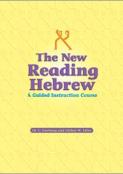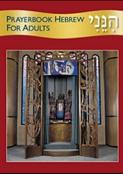- Home
- Play & Learn Home
- Online Enrichment
- Experience Modern Israel
- Israel It's Complicated
- Jewish and Me
- Jewish Holidays Jewish Values
- Jewish Values in Genesis and Jewish Values in Exodus
- Min Ha’aretz
- Our Place in the Universe
- Simply Seder
- The Prophets: Speaking Out for Justice
- Making T'filah Meaningful
- Make, Create, Celebrate
- Yom Haatzmaut Resources
- Hebrew Apps
- About The OLC
- What is the OLC?
- Introduction
- Get Started
- Resources
- OLC Content
- Parent Materials
- See My OLC Classes
- Store
Case Study: Using Shalom Uvrachah in a One-Day-a-Week Hebrew Class
Techniques to ensure strong decoding skills, to reinforce students' sense of mastery, and to successfully complete Shalom Uvrachah in one hour a week.
| Download Printable Version (PDF) |
Three years ago, Anne Lidsky had to figure out how to teach Hebrew to her 3rd and 4th- graders in one Hebrew session of 1½ hours per week-which sometimes includes a 20-30 minute prayer service or music. That left her with about an hour of Hebrew instruction. She needed to ensure that her students would be thoroughly familiar with all the letters and vowels before leaving alef class (3rd and 4th grades).
 |
| Dr. Anne Lidsky RJE, Director of Education at Temple Jeremiah, Northfield, Illinois. |
Anne, the Director of Education at Temple Jeremiah in Northfield, IL, selected Shalom Uvrachah to accomplish this task.
Anne chose Shalom Uvrachah for many reasons, among them the text's many reading opportunities, its variety of exercises, and a modern, attractive layout. She notes that each lesson opener shows students the letters and vowels they already know, reinforcing their sense of mastery, and that the heritage vocabulary and pictures help students relate to the new letters.
Anne is experiencing great success using Shalom Uvrachah with such limited instructional time. She says, "With Shalom Uvrachah, we are able to complete the text in a year, introducing the children to all the letters and vowels. In most cases, their decoding skills are very strong and their Hebrew experience a positive one at the end of the school year."
The success of Shalom Uvrachah at Temple Jeremiah is also due to the creative teaching techniques that the alef teacher, Joanie Siegel, employs. The key, Joanie finds, is to complete one lesson a week. There are 25 lessons in the book and 25-30 weeks in the school year. By planning ahead and pacing classes carefully, teachers can readily complete the book in a school year.
To encourage retention of the letters' names, shapes, and sounds, teachers should provide mnemonic clues to help students remember the sound of each letter. Students won't easily forget that tav has a "tiny toe," mem looks like a "man on the mountain," bet has a "belly button," and lamed looks like "lightning." The classes also have fun making up their own mnemonic clues.
Involving families in the learning process is also helpful. Teachers can call the home of an absent student and teach parents the mnemonic clue for the new letter. If the student has the textbook at home, the parents can teach him or her the new letter.
Below are eight more techniques teachers can employ to ensure that students successfully complete Shalom Uvrachah with just one Hebrew session per week. Click here for a complete listing of techniques to print out or forward to teachers.
-
Review material from the previous lesson at the beginning of each new lesson. Regular and ongoing review will help ensure retention of new information and drill new skills.
-
Assign 10-15 minutes Hebrew reading practice a night. Send home the textbook, a photocopied sheet from the Family Companion, or encourage students to review with Shalom Uvrachah Interactive CD. Have parents sign a homework sheet indicating that the assignment is complete, and how long their child spent doing it.
-
Consolidate two lessons if pressed for time. For example, teach the hirik ("ee" vowel) in Lesson 8 together with the ayin in Lesson 9.
-
Turn an activity in the book—for example, a Checkpoint—into a game. Students will review material and have fun at the same time.
-
Have students make their own set of Hebrew letter and vowel flash cards. Use the flash cards for in-class games and at-home practice. For an interactive family activity, suggest that students teach their parents the names and sounds of the letters and vowels. Kids will love it, and parents will learn a bit of Hebrew.
-
Bring in tutors to work one-on-one with students who require more assistance. This will allow progress with the remainder of the class. Try to choose empathetic as well as knowledgeable high school students. Youngsters can often relate best to them.
-
Pair or group students. Students of different ability can complete an activity together and review one another's work. Work alone with individuals during that period.
-
Assess letter and vowel recognition at the end of the school year. Have students fill in the names and sounds of the letters, and the sounds of the vowels. Use the Diagnostic Hebrew Reading Test or create a customized diagnostic tool.
Anne Lidsky has the final word: "I have been Director of Education at Temple Jeremiah for 22 years, and we have used a variety of primers during the course of those years. Shalom Uvrachah is a favorite in our school."







